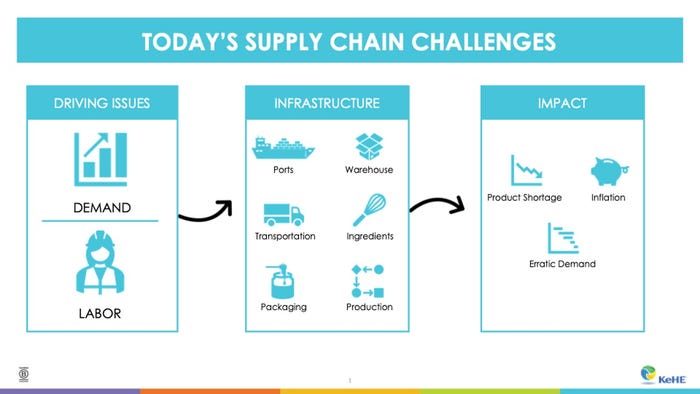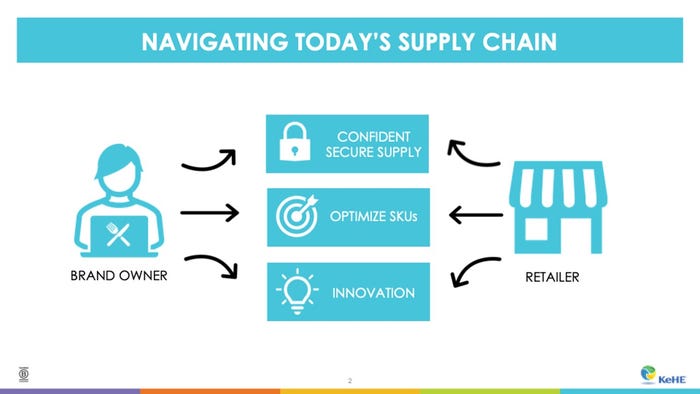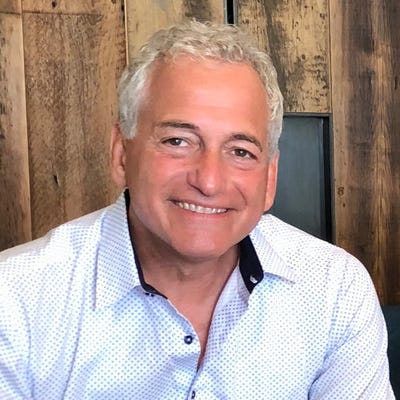Supply chain gridlock is the industry story this year. But agile and innovative companies can find solutions.

We've all seen the images of clogged ports, trucking backlogs and empty shelves; labor shortages and high consumer demand are driving a troubling period of inflation. And as COVID enters its third year, the challenges keep piling up.
Together they have turned supply chain into one of the biggest headaches for the U.S. and global economy.
For our “Overcoming Today’s Supply Chain Challenges” webinar, Naturally Chicago convened some of the Natural Products Industry’s top experts to explore the topic and offer possible solutions. The headliner was Brandon Barnholt, CEO of KeHE, one of the industry’s top distributors. KeHE distributes nearly 75,000 items and serves more than 30,000 stores from 17 distribution centers in the U.S. and Canada.
Barnholt predicted that supply chain challenges will continue “for a long time—with no quick fixes.” He noted that KeHE is in the front lines of the problem, stating, “Whenever you're moving as much freight as we do, whenever you're dealing with all the vendors and all the retailers and you're in the middle... We've had labor problems... We've had inventory problems. We've had all the same kinds of issues that everybody's dealing with.”
But difficult times can also unleash a wave of innovation. Barnholt and the other panelists stated that creative and agile companies can find solutions that help untangle the knots and create stronger links in their supply chains.
Causes of the Supply Chain Crisis

The first of two slides Barnholt presented during the webinar scoped out the roots of today’s challenges. “There's really two driving issues that are affecting everything that is happening in supply and demand and in the supply chain,” Barnholt said.
“We've got a very large increase in demand for our products...,” he said. “Food at retail in the U.S. is now pushing about $800 billion... On the natural organic side, we've now increased up to 15% of market share out of that $800 billion.”
He continued, “The second big driving issue is labor. We all hear about the Great Resignation. We know that there's been a tremendous amount of COVID-related absences. We've got family issues and babysitting, that is now a bigger part of our lives. And the result of all of that is that we've had a harder and harder time finding employees to do the work that that we need done.”
Setting Up Solutions

Barnholt’s second slide outlined solutions that brands should adopt to grease the supply chain skids.
Communication is crucial: “We've got to communicate better and we've got to understand the issues that we all deal with, whether we’re a brand owner or whether we’re a retailer or as us as distributors or wholesalers in the middle… What we're after, at the end of the day, is a more confident and secure source of supply.”
Focus on products that really move: “We've got to eliminate and optimize SKUs. Tougher and tougher decisions have to be made at all ends of the spectrum so that we can be sure that we've got the supply of the products that we need on the shelf, and that requires a lot of really tough conversations."
Innovation lives: “At KeHe alone, we brought in 875 new brands for total of 15,000 new SKUs, just in FY 21, when most people think that innovation would have been at an all-time low. In fact, it wasn't. So we need to continue to innovate, have that effect the offering on the shelf, and allow us all to secure our supply chains.”
The rest of the expert panel expanded upon solutions to the supply chain quandary. The following are key takeaways from each of the panelists.
Don't wait to purge your portfolio
Will Madden, Co-Founder, Whole Brain Consulting: “Your lower performing SKUs, get rid of them now. They're taking focus away from your sales team, your distributors team and your retailers, and you're not going to be able to keep them in stock anyway. So before you have problems in the discontinuations and the fines from everybody in the system for you not performing, go ahead and get rid of them. And your innovation has to be targeted.”
Avoid hub-and-spoke trucking gridlock
Jason Meklir, Chicago Office Managing Director, Flock Freight: “LTL [less than truckload] hub-and-spoke networks are… somewhat inefficient in nature, by the forward and back components having to reload and unload freight and have it handled through multiple different terminals. Also, with these changing buying habits as ecommerce rises and having to get freight closer to the customers, things of that nature, there are more and more amounts of business that is being flooded into those networks… If you're better able to pre-plan, find opportunities for consolidation, other customers that can help offset and share that cost for what you're going to be spending for the truck, it just allows you to have some cost relief in an area where this is only continuing to increase.”
Lean and Mean Sourcing
Kelly Mendricks, Head of Supply Chain and Operations, Brainiac Foods: “I would direct everyone to think about two things, the first being continuous improvement. One advantage of a small or early-stage product is that there's usually a little bit of room on the table… Sit down with the team and figure out where is their wait, where is their lead time too long, where AI complexity is being added, and then organize the opportunities for improvement in terms of ease and impact… The other thing I would encourage everyone to be thinking about is relationship… It's never too early to start talking to new folks.”
Whittle your cost margins
Hormis Tharakan, Chief Operating Office, General Assembly Pizza, and former Supply Chain Lead, Nature’s Path: “We've also looked at stuff like waste mitigation. So if you're running at 3%, 4%, 5% waste, if you can reduce that down, you can, using CI [continuous improvement], reduce that to 4% or improve that by 1 or 2%, you'll get cost savings there.”
Bob Benenson, Naturally Chicago consultant and publisher of Local Food Forum, contributed to this article.
About the Author(s)
You May Also Like




